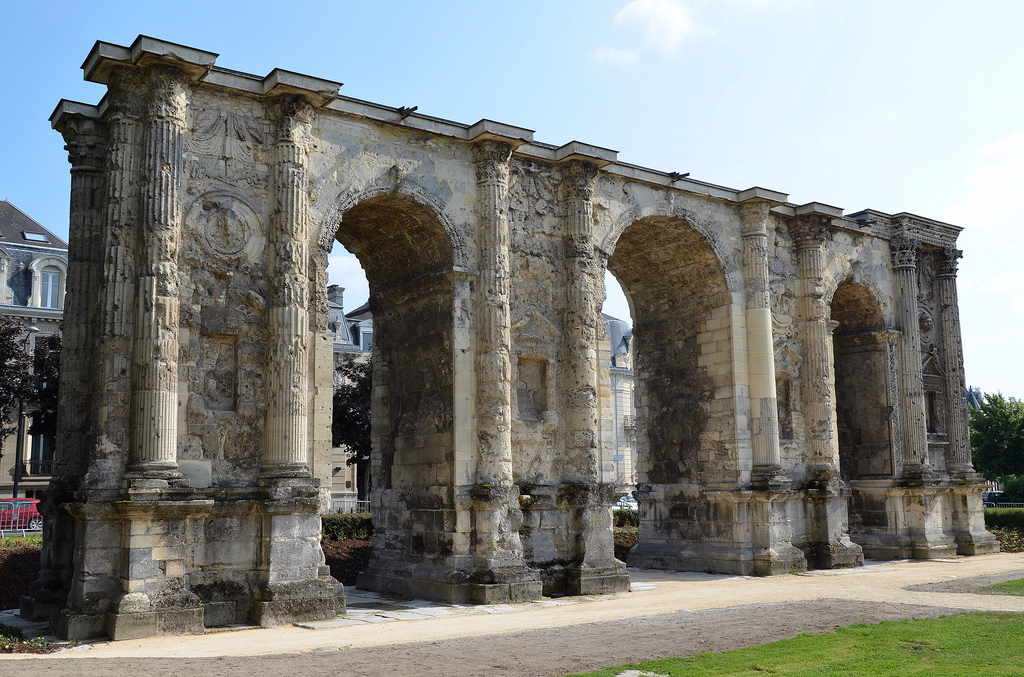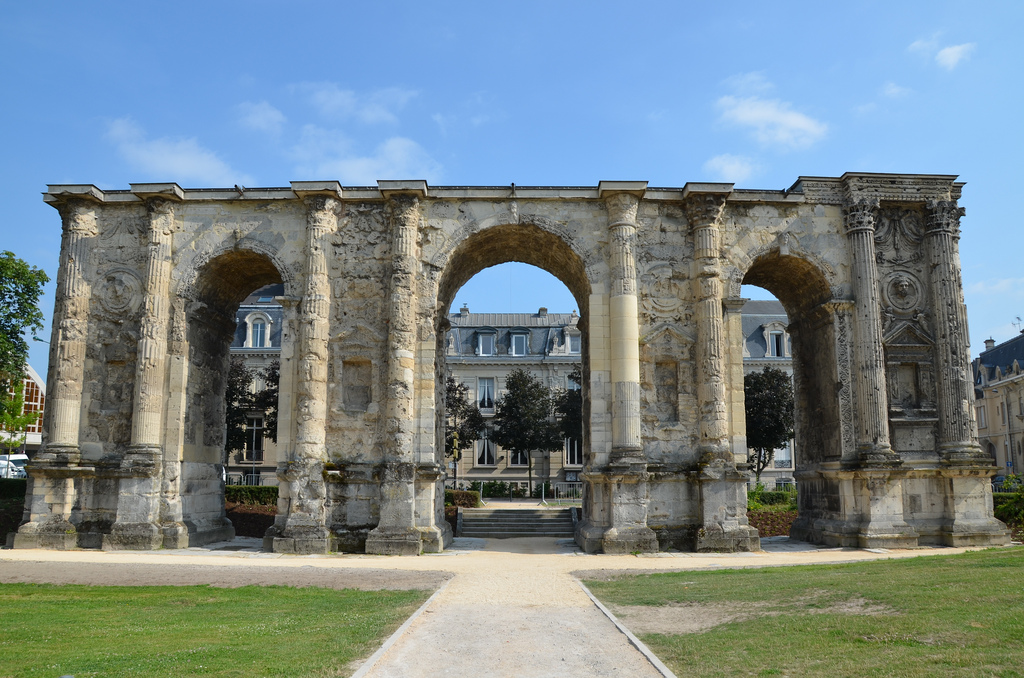The Porte Mars is an ancient Roman arch in Reims in the Champagne-Ardenne region, north of France. It dates from the early 3rd century AD and is the largest arch of the Roman world and one of the most impressive Roman monuments north of the Alps. Its name derives from a nearby temple dedicated to the god of war, Mars. At the time of its construction, the Porte Mars would have been one of four monumental arches erected as entrances to the Gallo-Roman settlement of Durocortorum.
Coordinates: 49° 15′ 38.2″ N, 4° 1′ 47.8″ E
The Arch, relatively well preserved, stands 32 metres long and 13 metres high, but its height must have been equally impressive with its attic and the statue group on top. It consists of three arches with eight Corinthian columns surmounted on undecorated plinths, between which are pedimental niches. Above the niches are shield-like medallions –clipei– with high relief heads supported by cupids. The central and largest arch is about 37 feet tall.

The arch has many highly detailed carvings on its exterior and on the ceilings of its three passageways. The ceilings of the side arcades are adorned with friezes portraying ancient legends and myths such as Remus and Romulus and Leda and the Swan. The ceiling of the central arch is of the most interest. It is decorated with reliefs depicting a harvest calendar and scenes of labourers, harvesters, reapers and millers. The seasons and the months of the year are illustrated by agricultural activities. One of the reliefs offers a rare and interesting illustration of a Gallic harvesting machine called a vallus, a reaping machine described by the historian Pliny the Elder in AD 77 (HN 18.72): “on the vast estates in the provinces of Gaul very large frames fitted with teeth at the edge and carried on two wheels are driven through the corn by a donkey pushing from behind; the ears torn off fall into the frame”.
Before the Roman conquest of northern Gaul, Reims founded circa 80 BC as Durocortōrum (“round fortress”), served as the capital of the tribe of the Remi, the first Belgic people north of the Matrona river (Marne). In the course of Julius Caesar’s conquest of Gaul (58–51 BC), the Remi allied themselves with Rome, and the city later became one of the leading cities in the province and the residence of the governor of Belgica. At its height, the Gallo-roman city, with its 30 000 inhabitants, was the most populated in the North of the Alps.

Reims is most famous for its cathedral, Notre-Dame de Reims, formerly the place of coronation of the kings of France. The Frankish king Clovis was baptised by Remi, bishop of Reims, on Christmas Day AD 498 in a baptistery today situated where the Notre-Dame Cathedral of Reims stands. Thanks to Clovis’ baptism, Reims became the seat of the coronation of the kings of France.
The Porte Mars was included in the fortification wall of the late Roman Empire and, in 1228, in the wall of the castle of the Archbishops and served as a city gate until 1544. In 1854 the buildings around the arch were removed, bringing the arch into full view. Most of the finds from Durocortorum are in the Musée Saint-Rémi.

Gravure d’Adrien Dauzats, éditée par Lemercier (Paris).
L’arc est encore pris dans le rempart médiéval (BM Reims 22-060).
PORTFOLIO




It is decorated with a pedimental niche, a clipeus (shield-like disk) with a high-relief head supported by cupids. Above are two crossed caducei (the staffs carried by Mercury) and two further cupids drawing back curtains.





Links:
- Wikipedia (in French)
- Inrap – Reims
- Durocortorum – The Princeton Encyclopedia of Classical Sites

Carole,
Excellent photowork, as usual! Well done!
LikeLiked by 1 person
Spectacular Carole. Stunning photo’s. Love these Roman Arches.
LikeLiked by 1 person